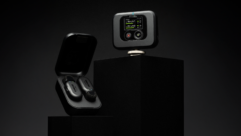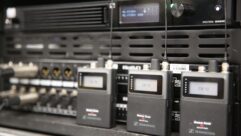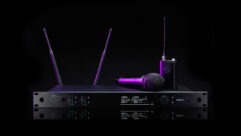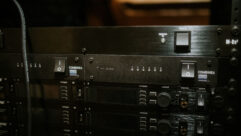Are you ready for July 13, 2020? That’s the date the Federal Communications Commission has set for wireless microphones to cease operation in the 600 MHz service band — and in some cases, it’s happening sooner. Mic manufacturers have been thinking about it for years, but it’s possible your customers haven’t, so it’s best to check in with them now. Thankfully, you’ll have a lot of options.
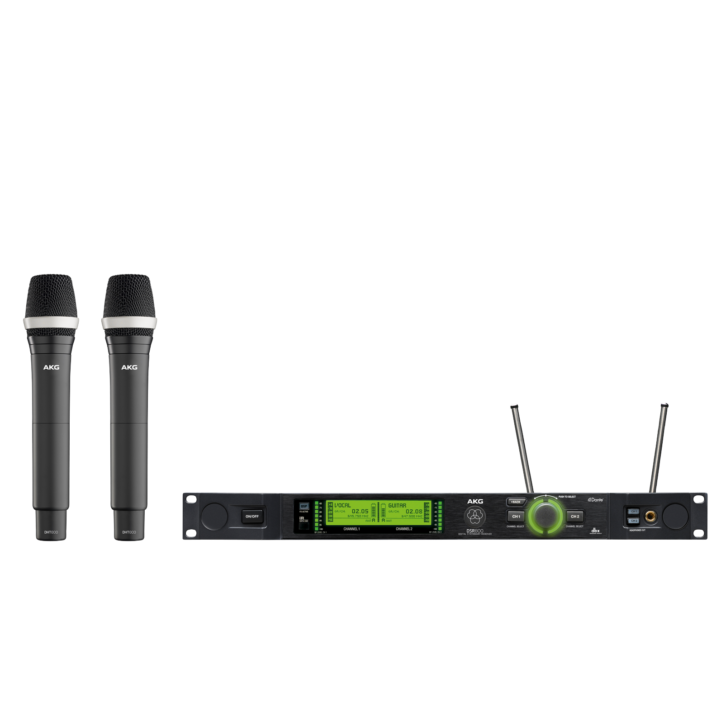 AKG’s DMS800 Reference Digital Wireless Microphone System features 512-bit encryption and a 150MHz frequency range for worldwide touring flexibility. It offers both Dante and AES/EBU digital audio outputs, and the DHT800 handheld transmitter’s microphone heads are exchangeable. Additionally, the mute switch of the transmitter may be set to work as a power switch. The DMS800 can be outfitted with the AKG D5 WL1, D7 WL1, or C5 WL1. Further, the DMS800’s optional network remote control allows frequency coordination and monitoring of multichannel systems by PC software Audio Architect, Apple iPhone/iPad/iPod, or Soundcraft Vi consoles.
AKG’s DMS800 Reference Digital Wireless Microphone System features 512-bit encryption and a 150MHz frequency range for worldwide touring flexibility. It offers both Dante and AES/EBU digital audio outputs, and the DHT800 handheld transmitter’s microphone heads are exchangeable. Additionally, the mute switch of the transmitter may be set to work as a power switch. The DMS800 can be outfitted with the AKG D5 WL1, D7 WL1, or C5 WL1. Further, the DMS800’s optional network remote control allows frequency coordination and monitoring of multichannel systems by PC software Audio Architect, Apple iPhone/iPad/iPod, or Soundcraft Vi consoles.
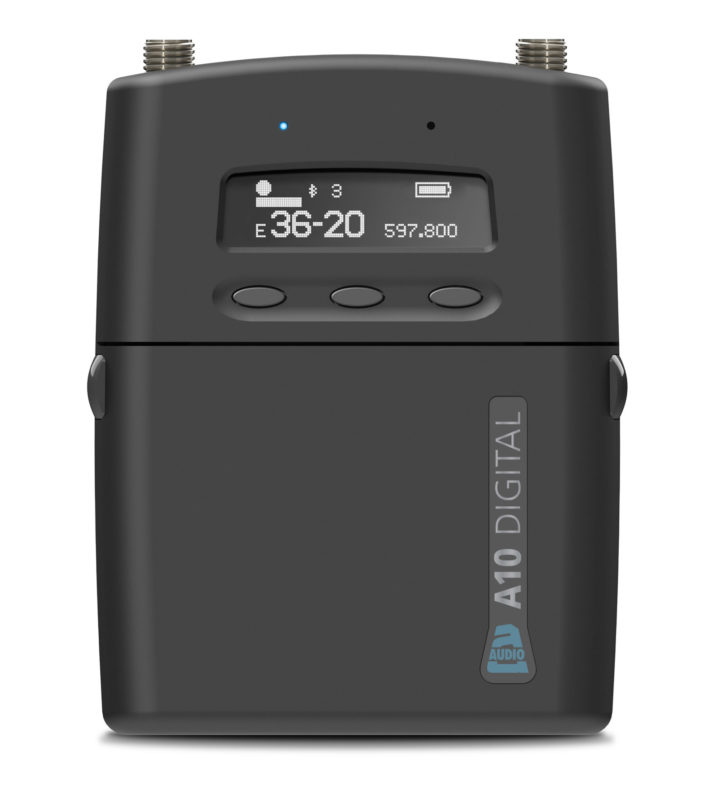 Firmware v2.50 is available for the Audio Limited A10 Digital Wireless System. A new feature, User Groups, enables a user to build a list of frequencies with names, allowing quick and easy tuning of the A10-TX and A10-RX. Sound professionals can match easy-to-remember names with pre-coordinated frequencies. When User Groups are loaded into the TX and RX, the frequency menus are simplified, showing only the user-selected frequencies. This eliminates tedious scrolling and provides a quick and easy way to set frequencies on location.
Firmware v2.50 is available for the Audio Limited A10 Digital Wireless System. A new feature, User Groups, enables a user to build a list of frequencies with names, allowing quick and easy tuning of the A10-TX and A10-RX. Sound professionals can match easy-to-remember names with pre-coordinated frequencies. When User Groups are loaded into the TX and RX, the frequency menus are simplified, showing only the user-selected frequencies. This eliminates tedious scrolling and provides a quick and easy way to set frequencies on location.
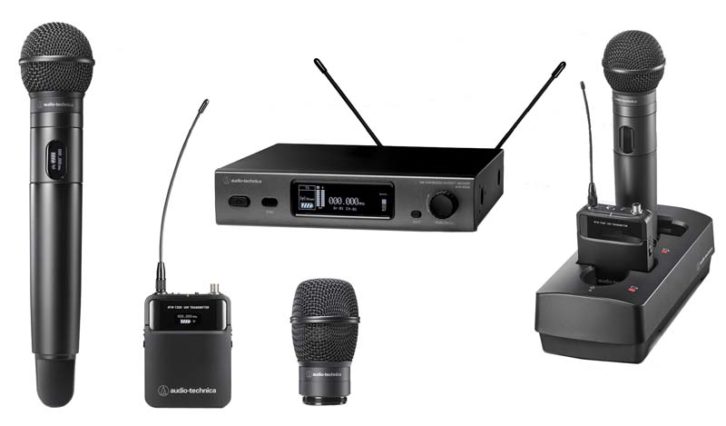 Providing easy setup, versatile operation, and detailed high-fidelity sound, Audio-Technica’s fourth-generation 3000 Series wireless systems give users the power and flexibility to operate within the congested UHF spectrum. With a 60 MHz tuning range (more than twice that offered by previous versions), 3000 Series systems are available in two frequency bands: DE2 (470-530 MHz) and EE1 (530-590 MHz). Frequencies can be scanned and selected on the receiver and then synced with the transmitter via IR sync functionality. The 3000 Series also lets users set a backup frequency that can be quickly swapped by pressing the transmitter’s multifunction button in the event of unexpected interference. Available system configurations feature an ATW-R3210 receiver along with an ATW-T3201 body-pack or ATW-T3202 handheld transmitter.
Providing easy setup, versatile operation, and detailed high-fidelity sound, Audio-Technica’s fourth-generation 3000 Series wireless systems give users the power and flexibility to operate within the congested UHF spectrum. With a 60 MHz tuning range (more than twice that offered by previous versions), 3000 Series systems are available in two frequency bands: DE2 (470-530 MHz) and EE1 (530-590 MHz). Frequencies can be scanned and selected on the receiver and then synced with the transmitter via IR sync functionality. The 3000 Series also lets users set a backup frequency that can be quickly swapped by pressing the transmitter’s multifunction button in the event of unexpected interference. Available system configurations feature an ATW-R3210 receiver along with an ATW-T3201 body-pack or ATW-T3202 handheld transmitter.
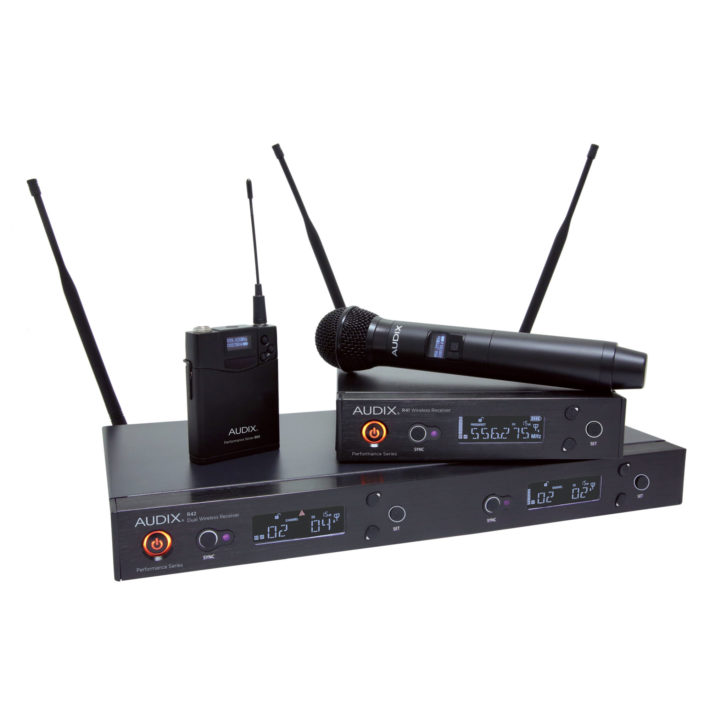 The Audix Performance Series of wireless products is divided into two groups: the 40 Series and the 60 Series, both of which are available in single and dual rack models. Common system features include one-touch auto scan searches; one-touch sync links transmitter to receiver via infrared beam; RF and AF indicators; high-contrast LCD displays; simplified, intuitive menus and a metal chassis; soft keys to control output levels, squelch, pilot, and lockout; choice of XLR or quarter-inch outputs; and a wide selection of handheld, instrument, headworn, and lavalier microphone options. The R42 is a two-channel diversity receiver including antennas, power supply, rack mount, and BNC cables for front mounting antennas. By adding the ADS48 antenna distribution system, a total of four R42 systems (eight channels of wireless) will fit into five rack spaces, operable from one antenna set.
The Audix Performance Series of wireless products is divided into two groups: the 40 Series and the 60 Series, both of which are available in single and dual rack models. Common system features include one-touch auto scan searches; one-touch sync links transmitter to receiver via infrared beam; RF and AF indicators; high-contrast LCD displays; simplified, intuitive menus and a metal chassis; soft keys to control output levels, squelch, pilot, and lockout; choice of XLR or quarter-inch outputs; and a wide selection of handheld, instrument, headworn, and lavalier microphone options. The R42 is a two-channel diversity receiver including antennas, power supply, rack mount, and BNC cables for front mounting antennas. By adding the ADS48 antenna distribution system, a total of four R42 systems (eight channels of wireless) will fit into five rack spaces, operable from one antenna set.
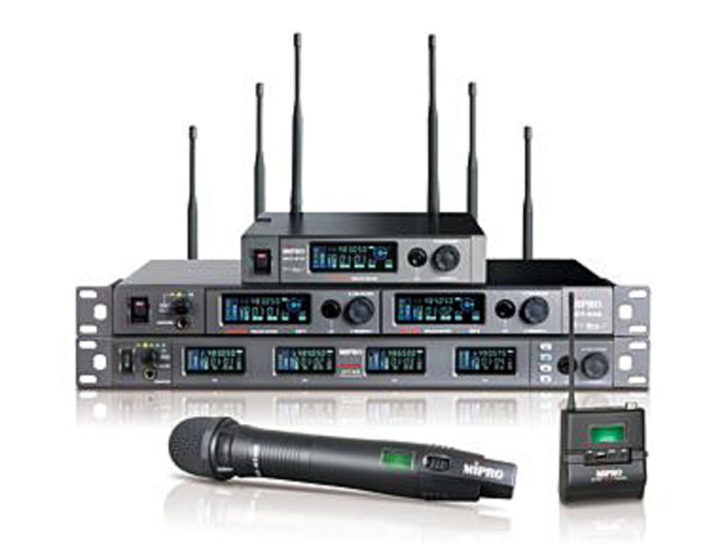 Avlex has announced that Dante audio networking capability has been added to select MIPRO wireless products. This feature is available on two ACT 7 Series wireless receivers, as well as the dual channel variant of the company’s ACT 8 Series product line. Additionally, the MIPRO ACT 8 Series product line has been expanded with the introduction of the ACT 848 digital wideband encryption-capable quad channel receiver, available in both standard and Dante-equipped versions. In addition to the availability of Dante audio networking functionality, the ACT-848 Quad Channel Receivers are true digital wireless receivers offering Digital Diversity Receiving Technology with available 256-bit encryption. In the ACT 7 Series product line, the ACT-72 Dante enabled uhf dual-channel wideband wireless receiver and ACT-74 Dante enabled uhf quad-channel wideband wireless receiver join the existing 7 Series UHF wireless receiver systems. MIPRO’s ACT 7 Series are premium analog wireless systems that operate across 72 MHz of bandwidth and offer 2,881 selectable frequencies with presets that allow up to 48 channel simultaneous operation.
Avlex has announced that Dante audio networking capability has been added to select MIPRO wireless products. This feature is available on two ACT 7 Series wireless receivers, as well as the dual channel variant of the company’s ACT 8 Series product line. Additionally, the MIPRO ACT 8 Series product line has been expanded with the introduction of the ACT 848 digital wideband encryption-capable quad channel receiver, available in both standard and Dante-equipped versions. In addition to the availability of Dante audio networking functionality, the ACT-848 Quad Channel Receivers are true digital wireless receivers offering Digital Diversity Receiving Technology with available 256-bit encryption. In the ACT 7 Series product line, the ACT-72 Dante enabled uhf dual-channel wideband wireless receiver and ACT-74 Dante enabled uhf quad-channel wideband wireless receiver join the existing 7 Series UHF wireless receiver systems. MIPRO’s ACT 7 Series are premium analog wireless systems that operate across 72 MHz of bandwidth and offer 2,881 selectable frequencies with presets that allow up to 48 channel simultaneous operation.
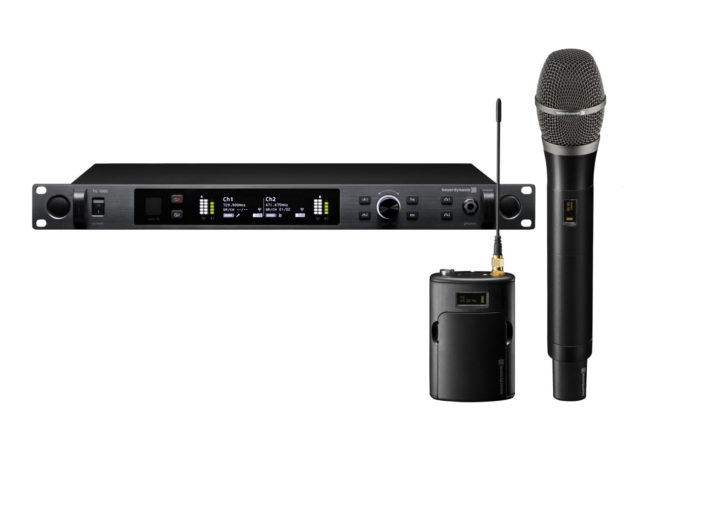 A new version of beyerdynamic’s 24-bit TG 1000 Wireless System features its dual receiver equipped with a Dante network interface via RJ45 connector with status LEDs on its rear panel. As such, the TG 1000 receiver offers both analog and digital output, the latter of which is ready for the flourishing Dante AoIP protocol by Audinate. Features of the German-made beyerdynamic TG 1000 include switching bandwidth of 319 MHz in the UHF range (470-789 MHz); high-contrast OLED UI display; one-button navigation; beyerdynamic’s own Chameleon software; optional proprietary encryption; and an impressive 2.1ms transmitter-to-receiver total latency. Up to six dual receivers can be cascaded without the need for external antenna splitters. In optimal environmental conditions, the TG 1000’s transition range can reach up to 984 feet.
A new version of beyerdynamic’s 24-bit TG 1000 Wireless System features its dual receiver equipped with a Dante network interface via RJ45 connector with status LEDs on its rear panel. As such, the TG 1000 receiver offers both analog and digital output, the latter of which is ready for the flourishing Dante AoIP protocol by Audinate. Features of the German-made beyerdynamic TG 1000 include switching bandwidth of 319 MHz in the UHF range (470-789 MHz); high-contrast OLED UI display; one-button navigation; beyerdynamic’s own Chameleon software; optional proprietary encryption; and an impressive 2.1ms transmitter-to-receiver total latency. Up to six dual receivers can be cascaded without the need for external antenna splitters. In optimal environmental conditions, the TG 1000’s transition range can reach up to 984 feet.
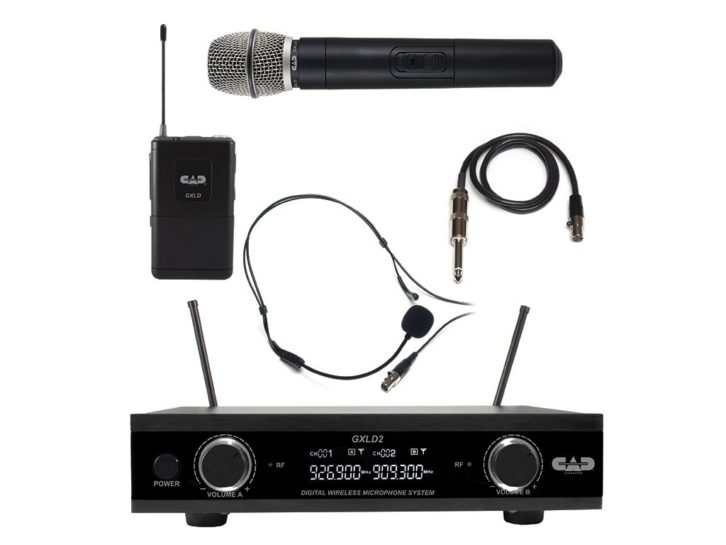 CAD Audio’s GXLD2 Digital Dual Channel wireless system includes digital high definition audio for clear, articulate sound and operates in the 900MHz band, free from TV and FCC regulatory issues. Other features include a high-contrast LCD display for easier readability in low light environments and advanced dipole antenna technology to increase usable operating distance. The receiver also includes balanced XLRM-type discrete outputs along with 1/4-inch unbalanced outputs for easy connection to 1/4- inch inputs. The system is available in three configurations: GXLD2-HH Dual Handheld, GXLD2-HB Handheld and Bodypack, and GXLD2-BB Dual Body Pack. All GXLD2 transmitters are equipped with On/Off and Mute functions along with low battery indicators. The dual handheld transmitters feature the exceptional sounding CADLive D38 capsule, while dual bodypack systems include a CAD condenser headworn microphone and a guitar cable.
CAD Audio’s GXLD2 Digital Dual Channel wireless system includes digital high definition audio for clear, articulate sound and operates in the 900MHz band, free from TV and FCC regulatory issues. Other features include a high-contrast LCD display for easier readability in low light environments and advanced dipole antenna technology to increase usable operating distance. The receiver also includes balanced XLRM-type discrete outputs along with 1/4-inch unbalanced outputs for easy connection to 1/4- inch inputs. The system is available in three configurations: GXLD2-HH Dual Handheld, GXLD2-HB Handheld and Bodypack, and GXLD2-BB Dual Body Pack. All GXLD2 transmitters are equipped with On/Off and Mute functions along with low battery indicators. The dual handheld transmitters feature the exceptional sounding CADLive D38 capsule, while dual bodypack systems include a CAD condenser headworn microphone and a guitar cable.
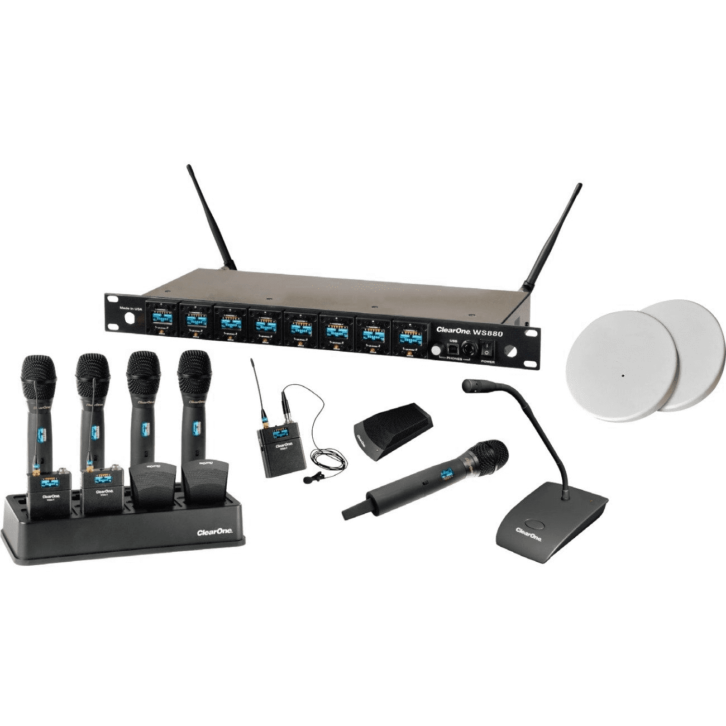 ClearOne’s WS800 and DIALOG 20 professional wireless microphones are now offered at a lower MSRP structure, making it easier for integrators to help customers upgrade their wired microphones with new, state of the art wireless products and to specify wireless microphones a standard component in many more new projects. The MSRP pricing structure is 20 percent lower than the previous pricing, and it is designed to help system integrators provide their customers with the most complete conferencing and sound reinforcement solutions. The WS800 system provides up to 24-bit, 48 KHz, digital audio RF technology in a working range of 300 feet, while the DIALOG 20 has a frequency response from 20Hz to 20kHz and its RF frequency is from 2.4 GHz to 2.483 GHz.
ClearOne’s WS800 and DIALOG 20 professional wireless microphones are now offered at a lower MSRP structure, making it easier for integrators to help customers upgrade their wired microphones with new, state of the art wireless products and to specify wireless microphones a standard component in many more new projects. The MSRP pricing structure is 20 percent lower than the previous pricing, and it is designed to help system integrators provide their customers with the most complete conferencing and sound reinforcement solutions. The WS800 system provides up to 24-bit, 48 KHz, digital audio RF technology in a working range of 300 feet, while the DIALOG 20 has a frequency response from 20Hz to 20kHz and its RF frequency is from 2.4 GHz to 2.483 GHz.
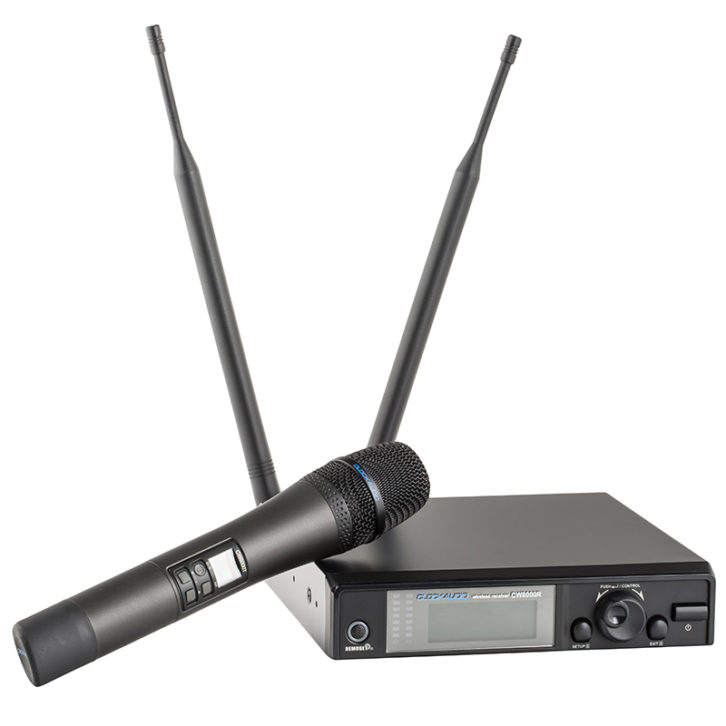 The Clockaudio CW 8000 is a UHF PLL personal wideband true diversity system that comprises one CW 8000T handheld radio microphone and one CW 8000R receiver. It features an operation distance of 200-480 meters and a maximum of 2,400-3,000 selectable frequencies across 60-75MHz. Its patented obstacles-free RF Remoset function synchronizes a transmitter simply by pushing a button. The CW 8000 also provides preset 12 groups each at maximum, and includes the user-programmable option of six groups each of 64 channels. Antenna boost power is provided for various external antenna installations.
The Clockaudio CW 8000 is a UHF PLL personal wideband true diversity system that comprises one CW 8000T handheld radio microphone and one CW 8000R receiver. It features an operation distance of 200-480 meters and a maximum of 2,400-3,000 selectable frequencies across 60-75MHz. Its patented obstacles-free RF Remoset function synchronizes a transmitter simply by pushing a button. The CW 8000 also provides preset 12 groups each at maximum, and includes the user-programmable option of six groups each of 64 channels. Antenna boost power is provided for various external antenna installations.
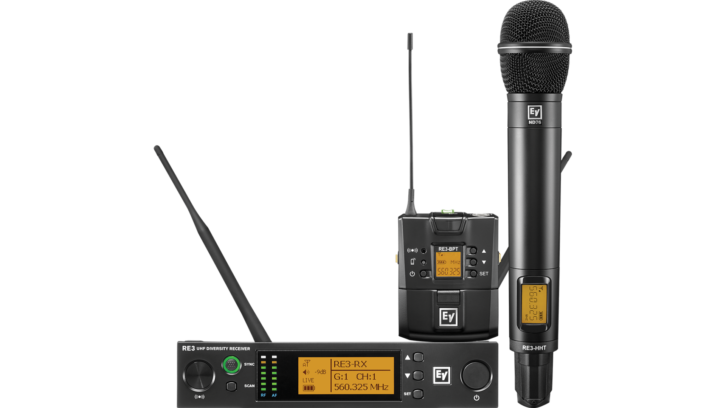 The RE3 is a UHF wireless microphone system from Electro-Voice available in 10 pre-packaged sets, configured to cover a wide range of performance and presentation applications. Sets contain one 1/2-rack-space diversity receiver with antennas, universal power supply, rack mount kit, transmitter, batteries, and an input device. The RE3 operates on three bandwidths for the North American market, including two 36 MHz-wide bands in the low and high 500 MHz spectrum, as well as one strategically chosen to operate within the 600 MHz duplex gap which the FCC has dedicated for wireless microphone use. Additional bands are also available for use in Europe and Asia, in the 600 MHz and 800 MHz ranges.
The RE3 is a UHF wireless microphone system from Electro-Voice available in 10 pre-packaged sets, configured to cover a wide range of performance and presentation applications. Sets contain one 1/2-rack-space diversity receiver with antennas, universal power supply, rack mount kit, transmitter, batteries, and an input device. The RE3 operates on three bandwidths for the North American market, including two 36 MHz-wide bands in the low and high 500 MHz spectrum, as well as one strategically chosen to operate within the 600 MHz duplex gap which the FCC has dedicated for wireless microphone use. Additional bands are also available for use in Europe and Asia, in the 600 MHz and 800 MHz ranges.
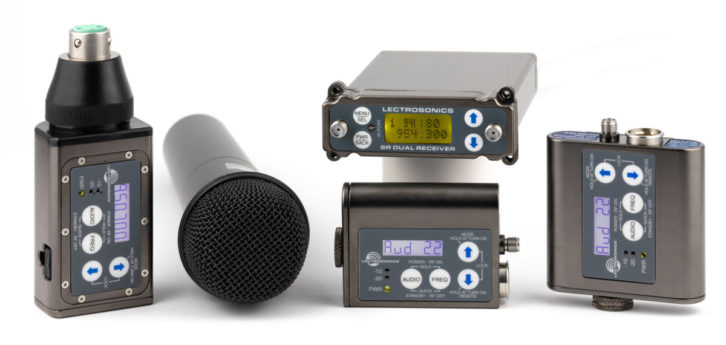 A selection of Lectrosonics Digital Hybrid Wireless microphone products are in the recently expanded 941-960 MHz frequency band for the United States. Products available in this new band are focused on ENG and field/production sound, and include the SRc-941 dual-channel modular portable receiver, the SMV-941 and SMQV-941 miniature belt pack transmitters, the HMa-941 plug-on transmitter, and the HHa-941 handheld transmitter. All transmitter models in this band offer 50 and 100 mW RF power settings. Otherwise, they are all functionally identical to the same units in the traditional UHF frequency blocks and bands. Likewise, all 941 units are compatible with the accessories for the same models in different frequency ranges, including external powering, audio connectors, microphones, belt clips and mounting options. The transmitters have a circular isolator in the output stage for additional intermodulation prevention, allowing closer spacing of RF carriers.
A selection of Lectrosonics Digital Hybrid Wireless microphone products are in the recently expanded 941-960 MHz frequency band for the United States. Products available in this new band are focused on ENG and field/production sound, and include the SRc-941 dual-channel modular portable receiver, the SMV-941 and SMQV-941 miniature belt pack transmitters, the HMa-941 plug-on transmitter, and the HHa-941 handheld transmitter. All transmitter models in this band offer 50 and 100 mW RF power settings. Otherwise, they are all functionally identical to the same units in the traditional UHF frequency blocks and bands. Likewise, all 941 units are compatible with the accessories for the same models in different frequency ranges, including external powering, audio connectors, microphones, belt clips and mounting options. The transmitters have a circular isolator in the output stage for additional intermodulation prevention, allowing closer spacing of RF carriers.
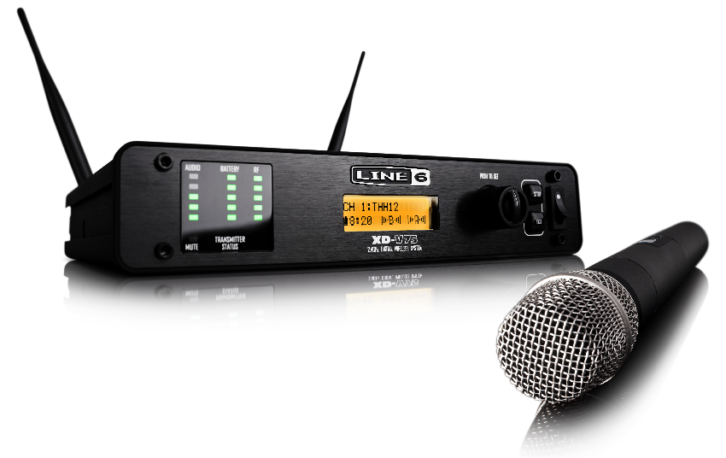 The Line 6 XD-V Wireless Microphone Series operates in the 2.4GHz ISM band, which is free from interference caused by TV broadcasts, white space devices, cell phone towers, and other transmitting devices. XD-V transmitters and receivers are designed to display essential system status quickly. Featuring clear visual displays, XD-V makes it simple to monitor battery levels and switch among up to 14 channels. Additionally, Relay G30, G50, G55 and XD-V35, XD-V55, and XD-V75 systems share the same technology, so it’s easy to combine handhelds, lavaliers, headsets and instruments within the same system, which also makes mixing and matching easy. XD-V75 systems include rack ears, antenna relocation accessories and rack-mounting hardware, making it easy to adapt to any professional installation. Multiple receivers interlock to create a compact multi-channel rack system. Finally, the built-in loop-through antenna distribution eliminates the need for additional external antenna units.
The Line 6 XD-V Wireless Microphone Series operates in the 2.4GHz ISM band, which is free from interference caused by TV broadcasts, white space devices, cell phone towers, and other transmitting devices. XD-V transmitters and receivers are designed to display essential system status quickly. Featuring clear visual displays, XD-V makes it simple to monitor battery levels and switch among up to 14 channels. Additionally, Relay G30, G50, G55 and XD-V35, XD-V55, and XD-V75 systems share the same technology, so it’s easy to combine handhelds, lavaliers, headsets and instruments within the same system, which also makes mixing and matching easy. XD-V75 systems include rack ears, antenna relocation accessories and rack-mounting hardware, making it easy to adapt to any professional installation. Multiple receivers interlock to create a compact multi-channel rack system. Finally, the built-in loop-through antenna distribution eliminates the need for additional external antenna units.
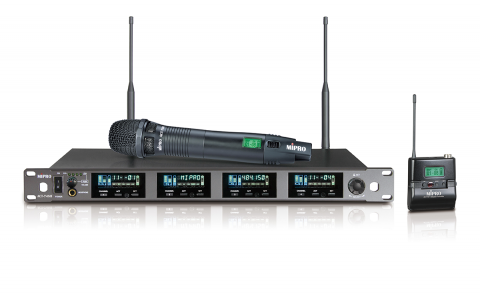 The stability of Mipro’s ACT-7 Series microphones RF stability is highly appreciated by audio experts. The microphones are ideal for broadcast, live sound production, conference and similar large venue applications. Features include IA standard rack-mountable receiver with metal chassis; advanced RF and IF circuitry to improve anti-interference characteristics and increase channel count; Dual “PiloTone & NoiseLock” circuits to minimize interference; 400 preset channels in compatible groups, plus a userdefined group: Auto Scan; ACT frequency sync to the transmitters; RF interference warning indicator; full-color VFD screen for clear viewing in day or night environments; realtime computer setup, control, and monitoring.
The stability of Mipro’s ACT-7 Series microphones RF stability is highly appreciated by audio experts. The microphones are ideal for broadcast, live sound production, conference and similar large venue applications. Features include IA standard rack-mountable receiver with metal chassis; advanced RF and IF circuitry to improve anti-interference characteristics and increase channel count; Dual “PiloTone & NoiseLock” circuits to minimize interference; 400 preset channels in compatible groups, plus a userdefined group: Auto Scan; ACT frequency sync to the transmitters; RF interference warning indicator; full-color VFD screen for clear viewing in day or night environments; realtime computer setup, control, and monitoring.
 Sennheiser wireless microphone systems, such as the new evolution wireless G4, SpeechLine Digital Wireless, Digital 6000, and Digital 9000 are compatible with Audinate’s Dante Domain Manager (DDM). The upgrade is provided free of charge via firmware updates to Sennheiser’s SL DI 4 XLR Dante interface, the EM 6000 DANTE microphone receiver, and EM 9046 DAN Dante card for the Digital 9000 wireless microphone system. Offering complete network management for systems based on the Dante multichannel audio networking standard, Dante Domain Manager software enables user authentication, role-based security and audit capabilities for Dante networks, while allowing seamless expansion of Dante systems over any network infrastructure.
Sennheiser wireless microphone systems, such as the new evolution wireless G4, SpeechLine Digital Wireless, Digital 6000, and Digital 9000 are compatible with Audinate’s Dante Domain Manager (DDM). The upgrade is provided free of charge via firmware updates to Sennheiser’s SL DI 4 XLR Dante interface, the EM 6000 DANTE microphone receiver, and EM 9046 DAN Dante card for the Digital 9000 wireless microphone system. Offering complete network management for systems based on the Dante multichannel audio networking standard, Dante Domain Manager software enables user authentication, role-based security and audit capabilities for Dante networks, while allowing seamless expansion of Dante systems over any network infrastructure.
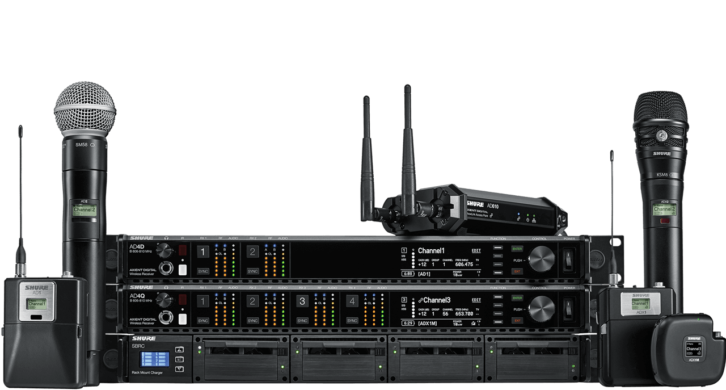 The Shure Axient Digital ADX series wireless transmitters offer enhanced features and form factors, including the ADX1 and ADX2 bodypack and handheld transmitters, ADX2FD frequency diversity handheld, and ADX1M, the first micro bodypack with an internal self-tuning antenna. ShowLinkenabled transmitters offer real-time remote control plus automatic interference detection and avoidance. The Axient Digital Wireless System features true digital diversity with Quadversity receiver technology, mitigating the potential for signal fades or interference that can cause dropouts. Quadversity mode enables users to place sets of diversity antennas in different zones, or double the number of antennas in a single zone, to improve RF signal-to-noise in challenging environments. High Density mode increases the maximum simultaneous system channel count from 17 to 47 per 6-MHz TV band (from 23 to 63 per 8-MHz TV band), while maintaining exceptional audio quality.
The Shure Axient Digital ADX series wireless transmitters offer enhanced features and form factors, including the ADX1 and ADX2 bodypack and handheld transmitters, ADX2FD frequency diversity handheld, and ADX1M, the first micro bodypack with an internal self-tuning antenna. ShowLinkenabled transmitters offer real-time remote control plus automatic interference detection and avoidance. The Axient Digital Wireless System features true digital diversity with Quadversity receiver technology, mitigating the potential for signal fades or interference that can cause dropouts. Quadversity mode enables users to place sets of diversity antennas in different zones, or double the number of antennas in a single zone, to improve RF signal-to-noise in challenging environments. High Density mode increases the maximum simultaneous system channel count from 17 to 47 per 6-MHz TV band (from 23 to 63 per 8-MHz TV band), while maintaining exceptional audio quality.
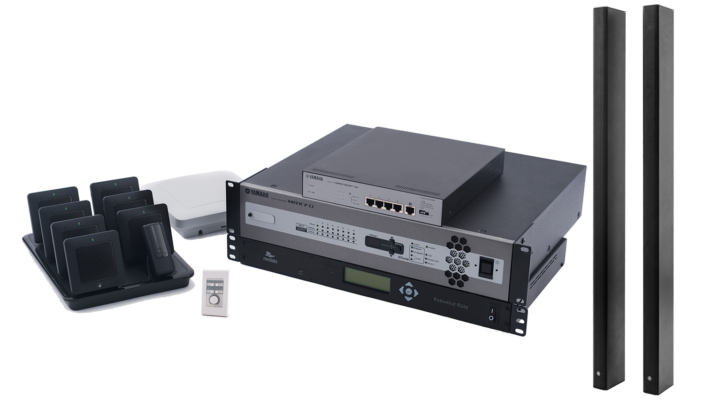 Yamaha Unified Communication’s YAI-1 Conference Ensemble debuted last year as a unique preconfigured audio conferencing solution for large conference rooms and boardrooms utilizing UC applications. It was designed for seamless and easy installation out of the box to bring Yamaha-quality audio to an organization’s chosen UC platform through a single USB cable. It comprises an eight-channel Executive Elite wireless microphone package, two VXL1-16P Power over Ethernet (PoE), Dante-enabled speaker arrays with wall volume controller, a preconfigured digital signal processor, a fiveport PoE switch, Dante AVIO USB adapter, and cabling, plus two 16-element PoE powered line array speakers and two microphone package options—gooseneck and table top.
Yamaha Unified Communication’s YAI-1 Conference Ensemble debuted last year as a unique preconfigured audio conferencing solution for large conference rooms and boardrooms utilizing UC applications. It was designed for seamless and easy installation out of the box to bring Yamaha-quality audio to an organization’s chosen UC platform through a single USB cable. It comprises an eight-channel Executive Elite wireless microphone package, two VXL1-16P Power over Ethernet (PoE), Dante-enabled speaker arrays with wall volume controller, a preconfigured digital signal processor, a fiveport PoE switch, Dante AVIO USB adapter, and cabling, plus two 16-element PoE powered line array speakers and two microphone package options—gooseneck and table top.
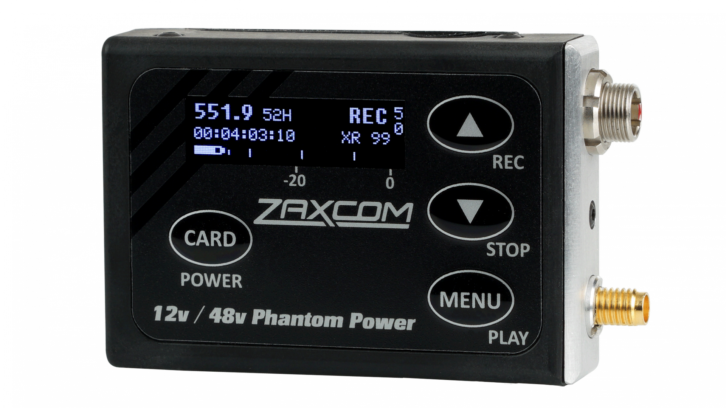 The Zaxcom ZMT3-Phantom 2 now supports both balanced phantom powered microphones as well as compatible unbalanced lavalier microphones. Zaxcom listened to customer feedback and created the ZMT3- Phantom 2 to fully support 12V, 24V, 36V, and 48V balanced microphones and 3.3V lavalier microphones. This new capability has been added to the ZMT3-Phantom 2 while maintaining the same size, weight, and power consumption of the previous model. Part of Zaxcom’s Digital Recording Wireless line, the new unit touts a 100 percent digital audio transmission that’s similar in quality to hardwired audio without compander, noise reducer, limiter, or compressor distortion. The new transmitter has a 100MHz RF tuning range and an impressive dynamic range of 110 dB.
The Zaxcom ZMT3-Phantom 2 now supports both balanced phantom powered microphones as well as compatible unbalanced lavalier microphones. Zaxcom listened to customer feedback and created the ZMT3- Phantom 2 to fully support 12V, 24V, 36V, and 48V balanced microphones and 3.3V lavalier microphones. This new capability has been added to the ZMT3-Phantom 2 while maintaining the same size, weight, and power consumption of the previous model. Part of Zaxcom’s Digital Recording Wireless line, the new unit touts a 100 percent digital audio transmission that’s similar in quality to hardwired audio without compander, noise reducer, limiter, or compressor distortion. The new transmitter has a 100MHz RF tuning range and an impressive dynamic range of 110 dB.


